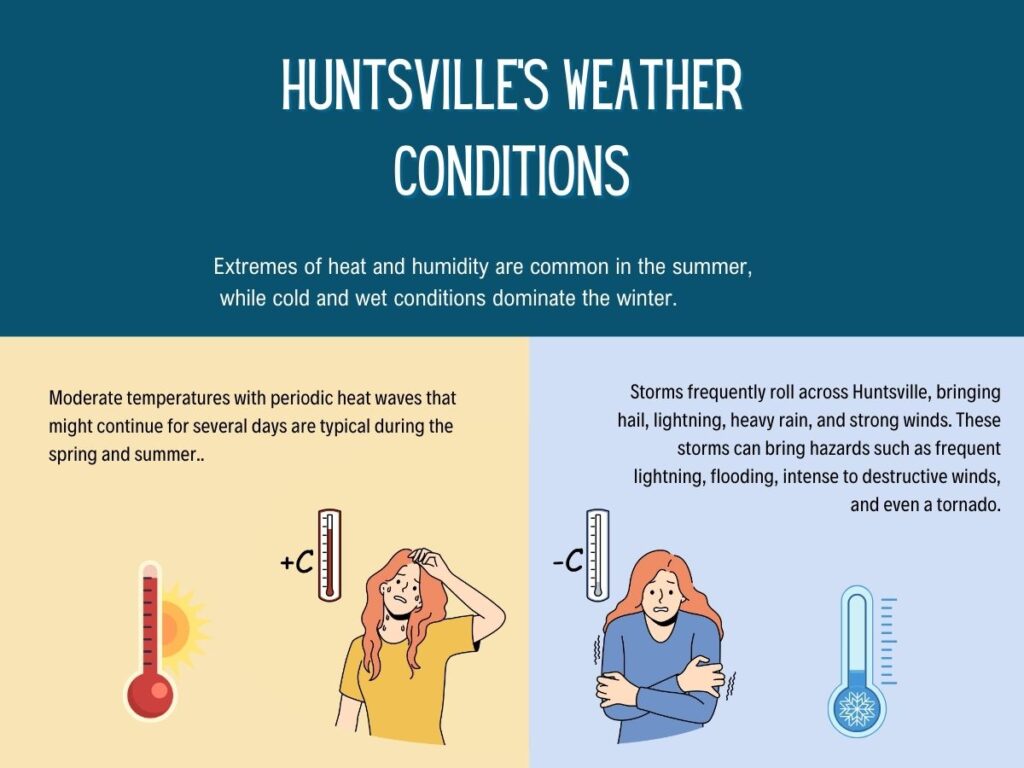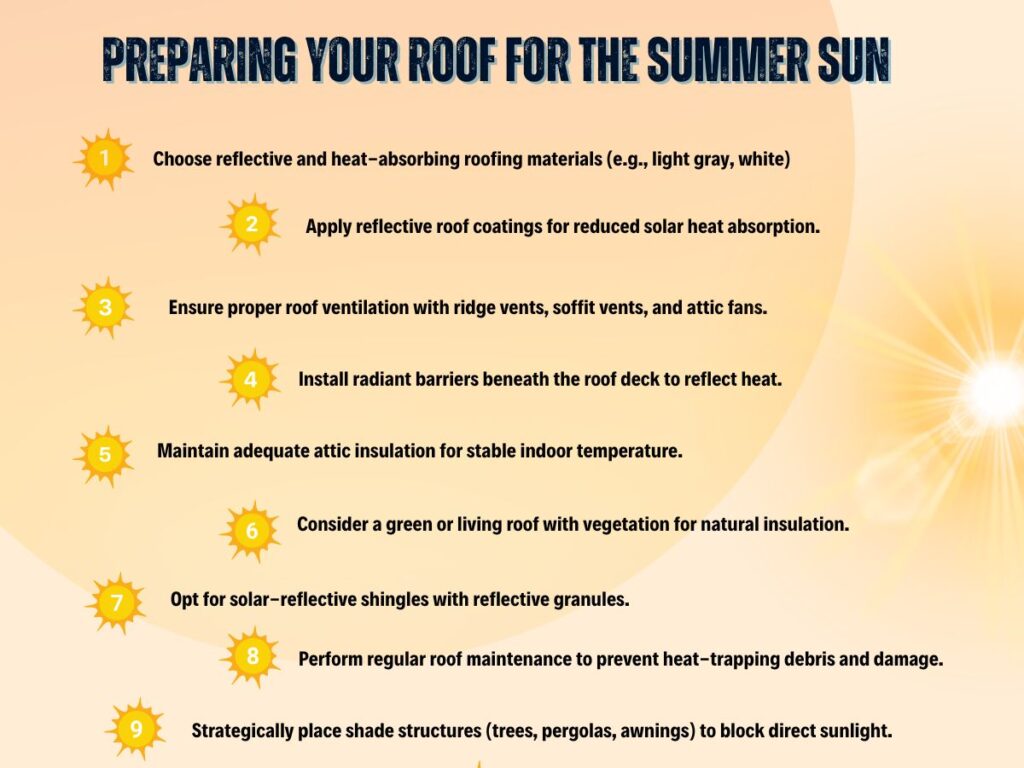Have you ever felt you'll run out of gas before reaching your destination, even though you know you can? Getting your roof ready for the weather in Huntsville is a lot like that feeling in your stomach. Living in Huntsville, Alabama, means seeing various weather conditions yearly.
The elements might damage your roof, especially if it isn't ready for the extremes of temperature that can occur over the year. While you may be comfortable with your roof's performance in typical conditions, you'll want to take precautions before Huntsville's unpredictable climate causes damage.
Do you know what needs to be done in preparing your roof for Huntsville's weather? This article explains what you need to do to protect your roof from the weather in Huntsville.
In Huntsville, Alabama, the weather can change in the blink of an eye. Extremes of heat and humidity are common in the summer, while cold and wet conditions dominate the winter.
Storms frequently roll across Huntsville, bringing hail, lightning, heavy rain, and strong winds. These storms can bring hazards such as frequent lightning, flooding, intense to destructive winds, and even a tornado.
Moderate temperatures with periodic heat waves that might continue for several days are typical during the spring and summer. During this season, there is a higher chance of flooding in low-lying areas due to frequent rain showers.
Even though Huntsville has a subtropical climate with moderate winters, the city can receive snow during rare winter storms. Huntsville receives an average of 1-2 inches of snow annually, although this snowfall is usually relatively light and infrequent.

How can knowing this help you when you plan to build a house, rebuild your roof, or strengthen it to withstand the weather in Huntsville?
Repairing your roof in an emergency can be very expensive, and depending on how bad the damage is and where it is, it may also be challenging and inconvenient for you and your family. It's best to be ready for roof damage from severe storms to reduce the likelihood of needing emergency roof repair.
Preventative maintenance is essential for a healthy roof. Your roof can last longer and stay in better shape by being prepared for the weather in Huntsville. Whether you own a home or a business, knowing the proper procedures for protecting your roof from the elements is crucial.
Hail can vary in size anywhere from the size of a pea (1/4 inch) to the size of a softball, depending on the weather. The size of the hail is an essential part of the damage it does.
The other factor is the rate at which the hail is moving. Hail can travel anywhere from 9 to 25 miles per hour, depending on size. Hailstones of quarter size travel at speeds of 25 to 40 mph, while those four inches in diameter can exceed 100 mph.
Hail is not something you can ignore. In the state, hailstorms are expected, so it's essential to be ready for them.
We've compiled a list of critical items to consider when preparing for hailstorms.
Find out precisely what is and isn't covered by your homeowner's insurance in the event of wind and hail damage by reviewing your policy. In most cases, it is covered, though your deductible may be different if hail rather than another catastrophe caused the damage. Your policy may not cover cosmetic damage from hail or high winds.
Hailstones gain momentum as they fall, and your roof is typically the first thing they'll smash on when they pass overhead. Hail can dent shingles, and strong winds can blow them loose or off the roof.
That lets water seep into the rafters and, ultimately, the attic. Over time, the aggregate surface of shingles can become loosened and washed away.
| Asphalt shingles | Hail rating |
| 3-Tab Asphalt | Class 1 or class 2 hail rating |
| Architectural (Dimensional) | Class 3 hail rating |
| Premium (Designer) | Class 4 hail rating |
Make sure to replace any shingles that are broken or missing regularly. More protective impact-resistant shingles may be worth looking at when it comes time to restore your roof.
Keep debris or leaves from building up in your gutters and downspouts. Water from excessive rainfall, including hail, can overflow gutters and pool around a building's foundation. The basement or crawl space walls will eventually succumb to hydrostatic pressure.
The lightweight metal used in gutters and downspouts is also vulnerable to damage from hail. Take into account replacing vulnerable components with stronger ones.
Hail guards, often made of metal mesh, shield rooftop equipment, including air conditioners, heat pumps, vents, and even skylights from flying debris. Hail significantly threatens the coils in air conditioner condensers and heat pump compressors.
Extreme summer weather conditions, both in temperature and humidity, can cause serious damage to your roof. During the summer, keep an eye out for these potential problems:
Having your roof inspected annually is your best defense against the summer sun. These inspections are essential because they allow your roofer to catch problems early and fix them before they can cause major, expensive damage.

Making your roof resistant to summer heat damage involves a combination of preventive measures and design choices. Here are some effective ways to achieve that goal:
Storms often come with high-speed winds that can cause significant damage to your roofing. Here's what you should know:
The ability of a roof to withstand strong winds is dependent on the building's size, shape, and design. Strong winds can cause more damage to buildings with a larger surface area, such as those with many corners and edges or a wide span.
Keep in mind that a roof's slope can affect its wind resistance while making building plans. Since the wind has less area to force against, a roof with a steep pitch will be more secure in strong winds than one with a gentle slope.
Ensure your roof is securely fastened and the installation is done correctly. This includes ensuring that the shingles, flashing, and metal roof seams are securely fastened.
New roofs vary in how well they resist wind depending on the materials used. In comparison to other roofing materials, asphalt shingles can withstand strong winds for the most part, and certain varieties of shingles even have extra features that boost their wind-resistance rating.
| Asphalt shingles | Wind rating |
| 3-Tab Asphalt | 60 to 70 mph |
| Architectural (Dimensional) | 110 to 130 mph |
| Premium (Designer) | up to 110 to 130 mph or higher |
When it comes to the long-term health of a roof, water damage can be one of the most destructive and expensive types of damage it can sustain. Extreme moisture, such as from melting snow or hail, can weaken or even destroy a roof in good condition if it soaks the shingles or other roofing components below the surface.
Further damage can be caused by water freezing and expanding between the shingles, metal roofing, or flashing layers. Leaks, mold, and mildew are all signs of water damage, and if your roof has any weak spots, they will only become worse over time.
Your roof may collapse or sag if water damage causes rot in the roof structure or deck. Water damage should be repaired as soon as possible after discovery to avoid costly and inconvenient consequences.
Making sure your roof is in good shape is the best defense against Huntsville's climate. If you want to protect your roof from water damage, you should inspect it often for missing shingles and damaged flashing and fix any of these issues as soon as possible.
Water can be kept away from your home's foundation by installing seamless gutters and extending them away from the building. Look for telltale signs of water pooling since this could indicate an issue that needs fixing before it gets out of hand.
You can prevent water from pooling around your house and seeping into the foundation by clearing up the gutters and downspouts twice a year. To make sure your roof is in good shape and ready for any weather, you may have a professional examine it once a year.
As previously mentioned, Huntsville's climate is a major factor to consider when selecting a roofing material for your home. If you want your roof to last through storms and other severe weather, you could choose one of the following durable materials:
Bad weather isn't predictable, and the rate of roof damage only goes down with maintenance. Therefore, roofs must be kept sturdy to shield people and their homes from severe weather damage.
Depending on what kind of weather event has affected your home, there can be different types of damage. Some weather-related damage is more noticeable, but the overall damage that is ultimately done to your roof ranges in severity.To reduce the damage and keep up with maintenance, here are some common roof problems and how to address them. You can also keep your roof storm-ready by scheduling routine expert roof inspections and maintenance with Southern Roofing Solutions in Huntsville and the surrounding areas.